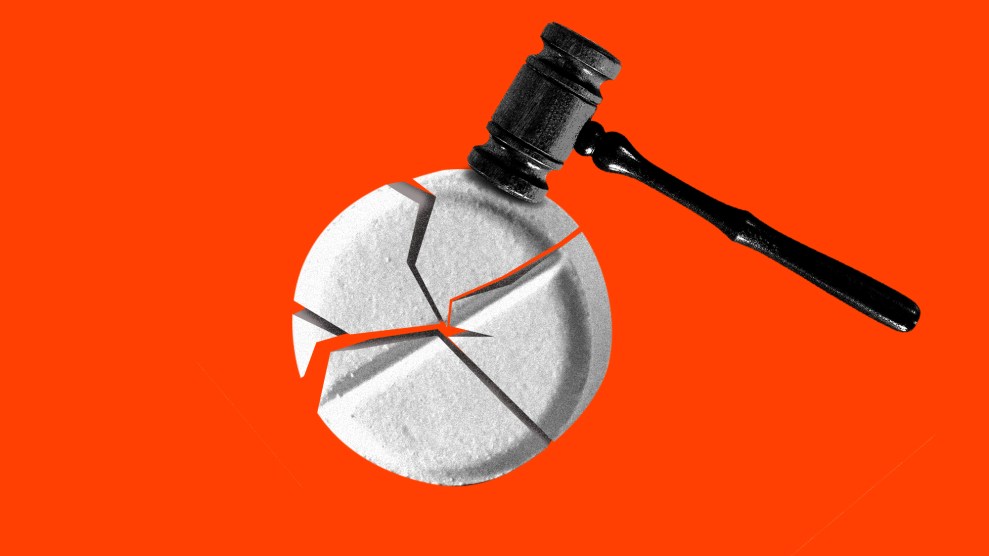
Olga Fedorova /SOPA Images/Sipa USA/AP
Earlier this spring, the Supreme Court hit pause on a controversial ruling in a massive anti-abortion lawsuit with the potential to eliminate nationwide access to the most common method of abortion. The case, brought by anti-abortion organizations and doctors, challenged the FDA’s two-decade-old approval of mifepristone, a pill used in medication abortion.
In April, a far-right federal district court judge in Texas had sided with the anti-abortion doctors, issuing an unprecedented order to suspend mifepristone’s approval. But before his decision could take effect, the Biden administration asked the Supreme Court to step in and pause the order while it went through appeals. The Court agreed.
On Wednesday afternoon, the conservative Fifth Circuit Court of Appeals issued its decision on the appeal, meaning the case is one step closer to reaching the Supreme Court. The Fifth Circuit ruled that the anti-abortion doctors had waited too long to challenge mifepristone’s FDA 2000 approval—and it also found that the FDA had acted improperly in 2016 and 2021, when it relaxed some rules around how mifepristone can be prescribed.
The Fifth Circuit’s decision contains bad news for parties on both sides of the case. But because of the Supreme Court’s prior order, the ruling doesn’t have much practical effect—at least for now. “This opinion changes nothing on the ground whatsoever,” says Drexel University law professor David Cohen. “Mifepristone is available the same way today as it was yesterday.”
The next stop for the lawsuit is still the Supreme Court. If SCOTUS takes the case, the justices would have the final word on mifepristone—upholding or invalidating the FDA’s approval, or throwing out the challenge altogether for procedural reasons. “They could do whatever they want,” says Mary Ziegler, a reproductive law expert at the University of California, Davis. According to Ziegler, the court could use the case as an opportunity to weigh in on the Comstock Act, a 19th century anti-obscenity law that abortion-rights opponents are trying to use to ban abortion nationwide. Their claim is that the old law, which makes it a crime to mail any “article or thing designed, adapted, or intended for producing abortion,” can be enforced.
If the Supreme Court takes the case, “everything is on the table,” Cohen says. “Everything from saying, ‘Everything the FDA has done is perfectly fine, go about your business,’ to ‘these people didn’t have standing in the first place.'”
Yet if the Supreme Court decides not to take the case, the Fifth Circuit’s decision on Wednesday would suddenly become relevant. FDA rules for prescribing mifepristone would snap back to the pre-2016 version, when use of the medication was restricted to patients under 7 weeks’ gestation, rather than 10 weeks. Currently, the FDA allows doctors to prescribe mifepristone by telehealth; if the Fifth Circuit ruling takes effect, patients would be required to visit doctors’ offices three times in person to complete a medication abortion, and virtual clinics would be eliminated.
There’s some debate among legal scholars over the extent to which doctors would be forced to follow some of these old FDA rules. According to Rachel Rebouché, dean at Temple University’s law school, providers could potentially still prescribe mifepristone off-label beyond the seven-week mark of pregnancy—especially since the World Health Organization says mifepristone is safe and effective through 12 weeks. But mifepristone might still become temporarily inaccessible, Ziegler says, because existing stock of the drug would suddenly be mislabeled. “Before any mifepristone could be used, it would have to be relabeled,” Ziegler explains. “So, for a time, it could mean no mifepristone access.”
Even in the worst-case scenario, where access to mifepristone is wiped out, medication abortion won’t be going away. Since the spring, in anticipation of restrictive rulings from abortion-hostile courts, providers have been preparing to offer medication abortion using a different medication called misoprostol. Typically, misoprostol is used in combination with mifepristone, but it also works on its own—it’s just more painful, and slightly less effective. “Nothing affects misoprostol only abortions regardless of whether the 5th Circuit’s opinion ultimately takes effect,” Rebouché writes in an email.
Additionally, the Supreme Court’s April decision to pause the Texas judge’s order is a good sign for abortion-rights supporters. “Usually the Supreme Court doesn’t do what it did, if it thinks the plaintiffs are going to win on the merits,” Ziegler explains. Greer Donley, an expert on abortion law at the University of Pittsburgh, agrees. “The Supreme Court could do anything when it takes the case, so it could invalidate the drug approvals,” she writes. “It is more likely that if the Supreme Court took the case…it would invalidate the entirety of the district court’s order.”
The big takeaway from Wednesday’s ruling? Don’t panic. Access to mifepristone isn’t changing today. “The high, high likelihood is that this Fifth Circuit ruling is going to be a historical aside with absolutely no ramifications for what ultimately happens,” Cohen says.
















